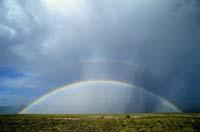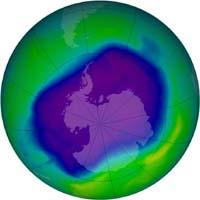Good news about the ozone layer
2007/09/30 Galarraga Aiestaran, Ana - Elhuyar Zientzia

It is certainly good news. The ozone layer is located in the stratosphere, 15-35 km from the terrestrial surface, and surrounds the entire planet. According to the winds, the time of year and other factors, in some areas it is thinner than in others, for example on Antarctica is quite thin in itself. And it has been reduced even more due to a series of gases emitted into the atmosphere by human activity. It has thinned down to the hole.
Now, after the decision made 20 years ago, it seems that the hole is closing. And that's good news, because the protective layer is recovering. In fact, the stratospheric ozone layer filters ultraviolet B (UVB) radiation from the Sun. Therefore, without it, the UVB radiation that reaches the terrestrial surface increases and that is harmful to living beings.

No ozone layer
Dermatologists know to what extent UVB radiation is harmful, as it can cause skin cancer and severe burns. Therefore, the sun protection creams incorporate an ultraviolet anti-radiation filter. UVB radiations act on cell DNA, which causes cells, by proliferating, present defects and cancer to occur. In addition, ultraviolet B radiation also affects the eyes and weakens the immune system. It also causes damage to other living things, plants, and aquatic ecosystems.
Another harmful effect for humans is related to tropospheric ozone. Curiously, ozone, although beneficial in the stratosphere, is harmful in the troposphere, the closest part to the earth. As the ozone concentration in the stratosphere decreases, the troposphere increases, causing problems and irritation of the respiratory system in people. It is also harmful to plants, which slow their growth; for example, crops decrease due to surrounding ozone.
The loss of the ozone layer also causes other damage. However, when in the 1970s scientists discovered that some gases destroyed the ozone layer, it cost society and politicians to worry about it.
Give the word and fulfill it

The researchers did not hesitate. It was found that gases containing chlorine or bromine destroy stratospheric ozone, of clean origin and produced by man. They were used in most cooling systems and also in aerosols. Now, moreover, they have discovered that these gases also contribute to the greenhouse effect.
Despite not knowing its impact on the climate, other consequences were sufficient to warn governments and society in general of the need to take measures. Little by little, those responsible for governments and people understood that something had to be done before it was too late. Finally, in September 1987, 29 countries signed the Montreal Protocol, with which they promised not to use these harmful gases for the ozone layer.
Since then, the Protocol has been subject to various reviews and has been signed by many other countries. Although not yet enough, researchers are seeing evidence that the ozone layer is recovering and believe that by the middle of this century it will be fully completed if the Montreal Protocol is fully complied with. So it will be!
Published in 7K.

Gai honi buruzko eduki gehiago
Elhuyarrek garatutako teknologia





